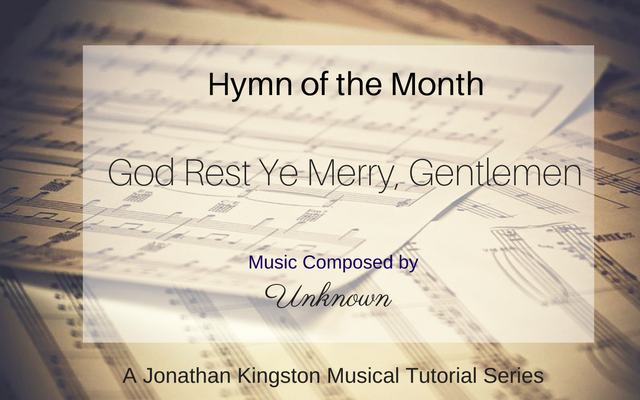Our final tune in this year’s series is befittingly the old English traditional Christmas carol “God Rest Ye Merry, Gentlemen”. The composer is unknown but there are records of it being sung within the Christian Church since the 15th century. The hymn was first put into print in 1760 but made available to a wider audience when William B. Sandy included a version of it in his publication Christmas Carols Ancient and Modern (1833). It has since been added to various hymnals and carol books.
“God Rest Ye Merry, Gentlemen” is written with an upbeat melody and speaking of the birth of Jesus in joyful terms. During the 15th century most religious songs were quite sombre and dark and offered little inspiration or joy so this song may have shocked church leaders but it certainly inspired the people. Crossing the ocean to both Europe and America, the carol later became a favourite throughout the Christian world and it is still sung in much the same way as it was hundreds of years ago.
In many respects, this is a deeply misunderstood carol. Part of the problem is punctuation, and part of the problem is the use of archaic words, specifically “rest” and “merry”. The word Rest means to keep or make and the adjective Merry had a wider meaning of prosperous, pleasant or joyful in early modern English. The sentence could possibly be rewritten as “God give you peace, gentlemen” or “God grant you joy, gentle ones”.
The song was famously referred to in Charles Dickens “A Christmas Carol”. In the below paragraph from the classic book, Ebenezer Scrooge chases away a Christmas caroller as he tries to sing the song in front of his house; “…at the first sound of ‘God bless you, merry gentlemen! May nothing you dismay!’ Scrooge seized the ruler with such energy of action that the singer fled in terror, leaving the keyhole to the fog and even more congenial frost”. With this we leave you to hopefully have a slightly less adventurous Christmas than Scrooge and may it instead be Joyful, Peaceful and bring you lots of Happiness!
This is played on our Envoy 35-F , which is a very popular church instrument.
More About Jonathan Kingston’s Musical Background
 Jonathan studied the organ with Professor Ian Tracey and Ian Wells of Liverpool’s Anglican Cathedral, home to one of the largest pipe organs in the world. He was appointed Organ Scholar, and subsequently Sub-Organist to Bradford Cathedral before securing positions as Assistant Director and Director of Music at two leading independent schools. He is currently Associate Director of Music at the Ordinariate Church of Our Lady of the Assumption, Piccadilly.
Jonathan studied the organ with Professor Ian Tracey and Ian Wells of Liverpool’s Anglican Cathedral, home to one of the largest pipe organs in the world. He was appointed Organ Scholar, and subsequently Sub-Organist to Bradford Cathedral before securing positions as Assistant Director and Director of Music at two leading independent schools. He is currently Associate Director of Music at the Ordinariate Church of Our Lady of the Assumption, Piccadilly.
Jonathan’s Work With Viscount
Jonathan works with us as our very own inhouse organist – he covers several areas from sales, demonstrations, voicing of instruments and performing. His playing features on the current promotional DVD material for Viscount, and he would be very pleased to hear from any churches or individuals requiring an engaging and lively recitalist. If you would like to connect with Jonathan directly, please feel free to follow him on Twitter (@jonkingston) or by email on jonkingston@hotmail.co.uk.
More About the Organ Being Played In This Demonstration
Jonathan plays this piece on our very own Envoy 35-F A ‘Physical Modelling’ based instrument with 35 stops in a real wood veneer cabinet. It has a huge internal library allowing the user to create 4 totally individual voice pallets from classic English through Baroque and Romantic. It benefits from a full complement of divisional thumb pistons and additional toe pistons. This organ also has a full 32 note pedal. For more information have a look at its specifications here.
I have had a passion for church organs since the tender age of 12. I own and run Viscount Organs with a close attention to the detail that musicians appreciate; and a clear understanding of the benefits of digital technology and keeping to the traditional and emotional elements of organ playing.



